Is Kotter’s 8 Step Change Model Still Relevant Today? What are the Pros & Cons of Kotter’s Approach to Change Management?
 Ready to Master Change? Discover the Secrets with John Kotter’s 8-Step Symphony!
Ready to Master Change? Discover the Secrets with John Kotter’s 8-Step Symphony!
Embarking on a journey of organizational change? Feeling a bit overwhelmed by the prospect of navigating the complexities of transformation? Fret not! We’re here to guide you through the terrain of change management using a trusted and proven framework – John Kotter’s 8-Step Change Model.
Get ready to embark on a journey where we break down each step into digestible insights, sprinkled with a touch of encouragement and a dash of humor. After all, change might be constant, but it doesn’t have to be intimidating!
So, buckle up and get ready to explore how Kotter’s 8-Step Change Model can empower your organization to not only adapt to change but to thrive in the face of it. Let’s turn those challenges into opportunities and set sail for a future of positive transformation. Let’s dive in!
Ready for a glimpse into what lies ahead? We’ve prepared a concise overview just for you. Brace yourself to explore the intricacies of John Kotter’s 8-Step Change Model, and remember, we’re here to accompany you on this voyage of exploration.
Quick Summary
The Upsides and Downsides: Assessing the Effectiveness of Kotter’s Approach to Change
John Kotter’s change management approach identified key obstacles faced by companies like Ford, General Motors, and British Airways during business change implementation. The 8-step change model he proposed aimed to address these barriers and enhance the effectiveness of change programs. However, the question arises whether Kotter’s theory remains relevant today.
Pros of Kotter’s Change Management Theory:
- Structured Approach: The 8-step model provides a systematic and structured framework for managing change.
- Focus on Leadership: Emphasizes the crucial role of leadership in driving and sustaining change.
- Broad Applicability: Initially designed for large corporations, the model can be adapted for various organizational sizes.
Cons of Kotter’s Change Management Theory:
- Linear Nature: Some critics argue that the model is too linear and may not accommodate the complexities of certain changes.
- Limited Flexibility: It might not be as adaptable to rapidly changing environments or industries with dynamic shifts.
- Top-Down Emphasis: The model often places a heavy emphasis on top-down leadership, potentially overlooking grassroots innovation and involvement.
In comparison to Kotter’s model, there are more recent and data-driven change management methodologies. The Prosci Change Management Framework, widely used in the U.S., Australia, APAC, and North America, focuses on individual transitions during change. The ACMP International Change Management Professional™ (CCMP™) model, popular in the UK and Europe, emphasizes a holistic approach, integrating individual, organizational, and change management competencies.
Ultimately, the choice between these models depends on the specific needs and context of the organization undergoing change. Some may find Kotter’s model a solid foundation, while others may opt for newer, more tailored methodologies that align with the evolving landscape of organizational change.
Strategic Blueprints for Transformation: Diving into the Realm of Change Models
Change models are frameworks that guide successful organizational transitions. They provide steps and methodology to navigate alterations in daily work, such as adding locations, products, or undergoing mergers. Examples include the John P. Kotter leading change method, Prosci ADKAR® Model, Kurt Lewin Change Model, and McKinsey’s 7-S Model. A lack of a change model and plan contributes to the ineffectiveness of over half (53%) of organizational change efforts, according to a KPMG Global Transformation Study. The success of change implementation is heavily influenced by the chosen approach, making structured models like Kotter’s 8 Steps popular for achieving successful transitions.
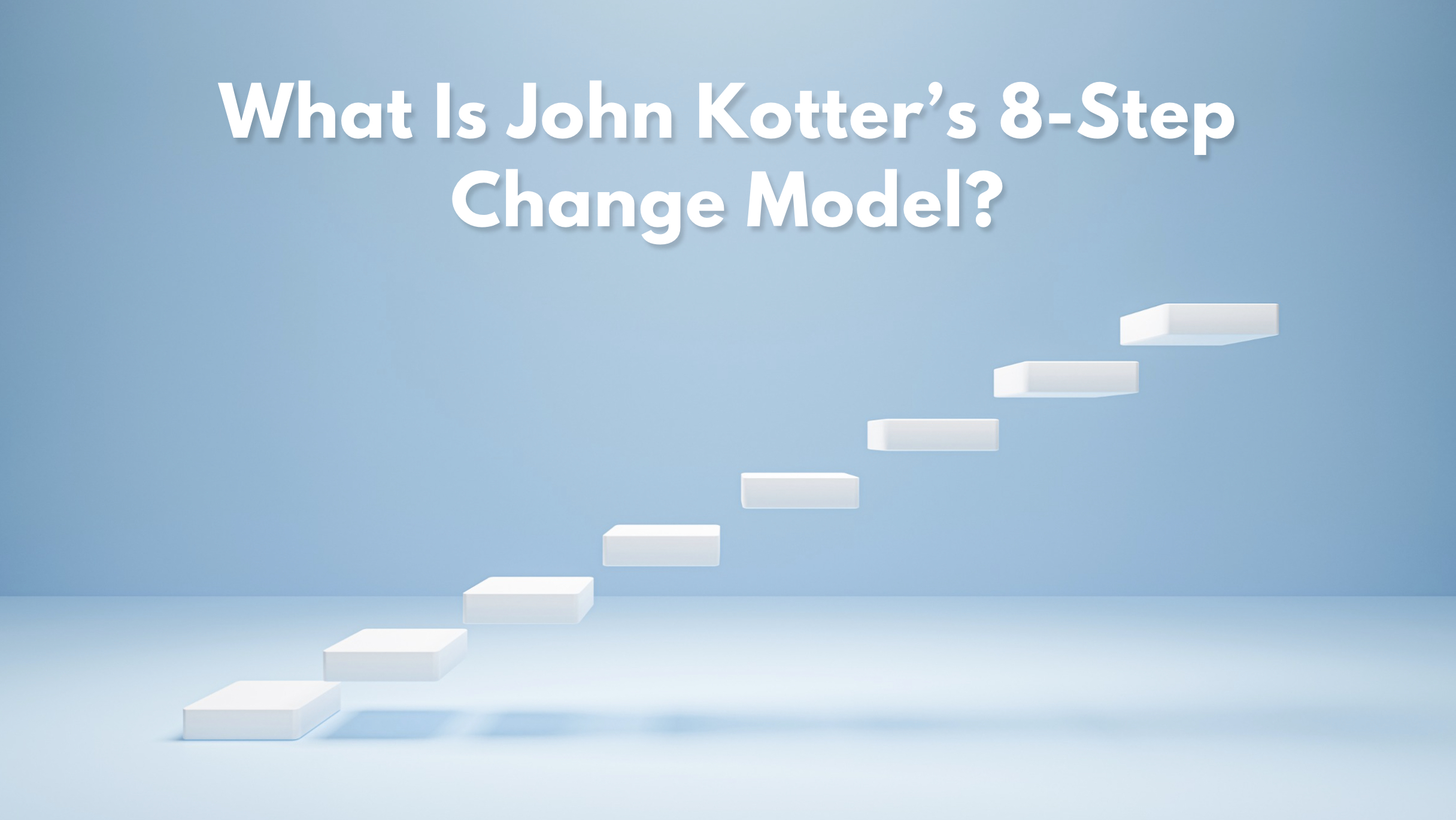
Kotter’s Blueprint: Unveiling the Dynamics of Organizational Change
The Kotter Change Model, created by Dr. John P. Kotter, is an eight-step change management framework that takes a top-down approach, emphasizing a sense of urgency. Kotter’s background in business administration and management science influenced the development of this model. The 8-step process is designed to create the right environment for change, secure necessary support, and maintain momentum throughout the change process. The model includes both a Change Process with 8 steps and Change Principles involving 4 key guiding principles. Its straightforward stages make it beneficial for those new to change management.
Deciphering Kotter’s Transformation Framework: Origins and Effectiveness
The John Kotter Change Model, introduced in 1995, comprises eight steps aimed at addressing barriers observed in companies undergoing transitions. Developed by Dr. John Kotter, based on his extensive experience overseeing over 100 companies’ transformations, including Ford, General Motors, and British Airways, the model emphasizes the need to create a sense of urgency for successful change.
Kotter’s 8-step model originated from lessons learned by studying both failed and successful change projects. It emphasizes the following points:
- Successful change processes require a series of steps that take time, and skipping steps can lead to project failure.
- Critical mistakes at any phase of change can have a devastating impact.
The 8 steps are derived directly from eight errors witnessed in companies undergoing change. The overarching philosophy of the model is the imperative need to create and maintain a sense of urgency throughout the change process. Kotter emphasizes the challenge of regaining momentum and combating complacency if urgency diminishes, highlighting the importance of sustained momentum for successful change implementation.
Strategic Evolution: Understanding and Implementing Kotter’s 8 Steps
John Kotter’s 8 Steps to Change Management aim to address common errors observed in organizational change. The steps are designed to correct these errors and guide successful change implementation:
- Create a Sense of Urgency: Key to all steps, emphasizes the need for motivation and understanding of change benefits.
- Build a Guiding Coalition: Form a diverse team of leaders to communicate the change vision effectively.
- Form a Strategic Vision and Initiatives: Develop a clear, communicable, and energizing vision and strategic initiatives.
- Enlist a Volunteer Army: Mobilize volunteers or change champions to drive and champion the change.
- Enable Action by Removing Barriers: Identify and eliminate obstacles hindering the change, such as bureaucracy and resistance.
- Generate Short-Term Wins: Establish and celebrate quick wins to maintain momentum and show progress.
- Sustain Acceleration: Be relentless in pursuing the next steps after achieving short-term wins to prevent complacency.
- Institute Change: Ensure the change is sustained and anchored in the corporate culture, connecting new behaviors to organizational success.
Kotter’s model, introduced in 1995, is based on observations from various organizational change projects, aiming to provide a corrective action framework for successful change implementation. The steps emphasize the creation of urgency, effective leadership, clear communication, and the anchoring of new behaviors in the organizational culture.
Detailed Deep Dive
John Kotter’s approach to change management was published in 1995 and it outlined key barriers to change that small, mid-sized, and large companies like Ford, General Motors, and British Airways were running into when they tried to implement a business change.
Kotter’s 8 step change model was introduced to help companies overcome these key barriers, and improve their business change programs. However, is Kotter’s change management theory still relevant today? What are the pros and cons in Kotter’s change management theory?
There is a wide range of other more recent and data driven change management methodologies including the Prosci Change Management Framework, which is widely used by U.S., Australia, APAC, and North America organizations, as well as the the ACMP International Change Management Professional™ (CCMP™) change model which is more popular with UK and European firms.
How does the Kotter change management theory compare to these and other more popular change methodologies? Pros and cons of Kotter change model?
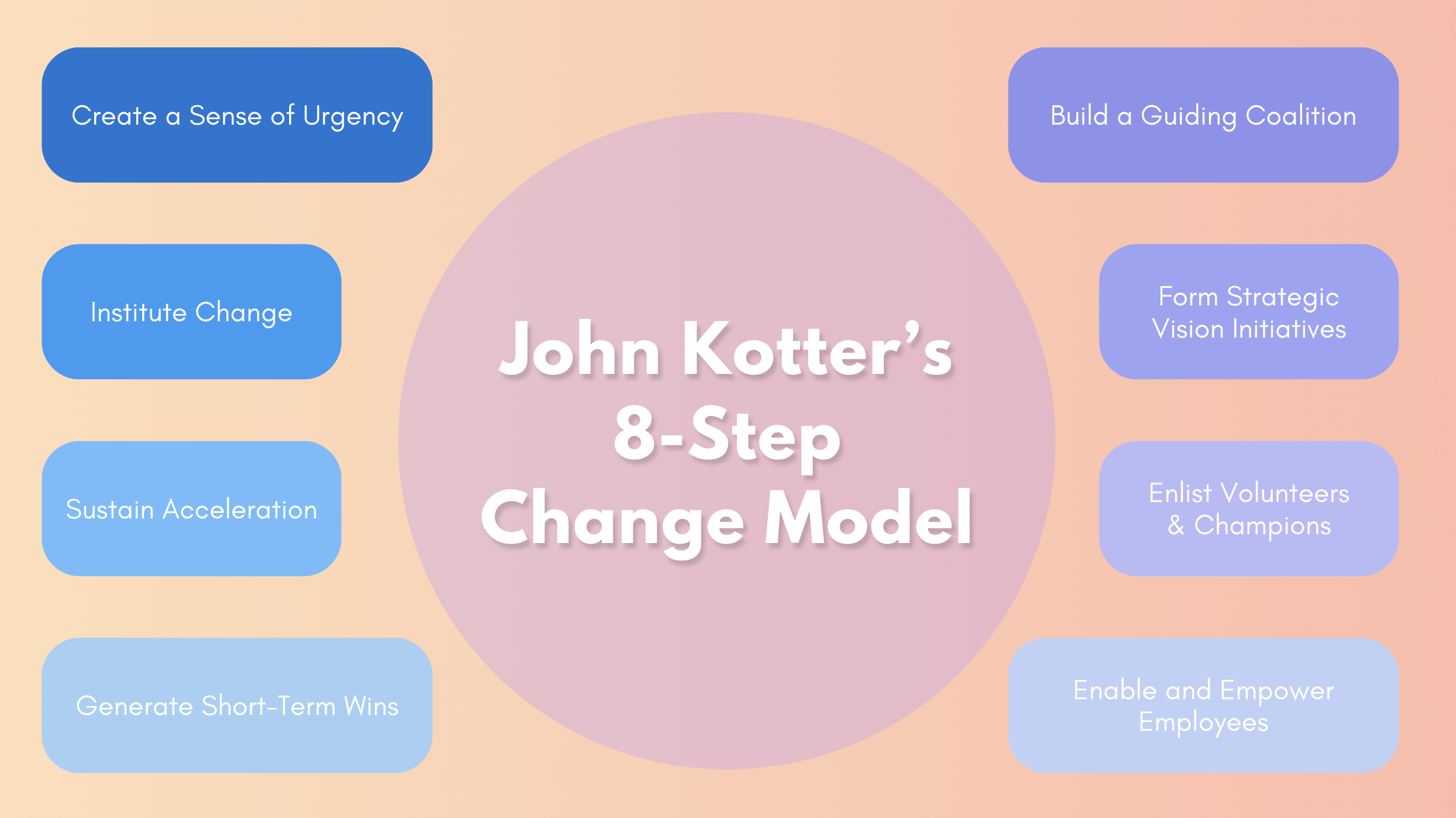
Kotter’s 8 step change model (diagram) – OCM Solution guide: Pros and cons of Kotter change model.
Kotter’s Approach to Change Management Overview Guide
This review guide on John Kotter’s change model provides you with an end-to-end overview of what you really need to know about John Kotter’s 8-Step Change Management Model.
Looking at the pros and cons of Kotter’s change model is an excellent way to decide if it’s a good fit for your change team and organizational needs.
You don’t want to just jump in and choose the first change model you run across; otherwise, you could end up having problems.
In this article, you’ll learn all about the Kotter change management model and how it works. We’ll also go through Kotter’s 8-step change model pros and cons, and a comparison between Kotter’s eight steps and another popular change model.
Here are some of the frequently asked questions this guide will answer:
- What are Change Models?
- What is the Kotter Change Model philosophy?
- What is Kotter’s theory of change?
- Why use Kotter’s 8 step change model?
- How can businesses apply Kotter’s eight-step model?
- How does the John Kotter change model compare to Lewin’s model?
If you’ve ever wanted to learn more about Kotter’s 8-step change model examples used to drive successful change, this definitive guide will tell you everything you need to know.
Why is John Kotter’s 8-Step Model so Popular?
The Kotter 8-step model is popular because it offers an easy-to-understand roadmap that change managers can follow, even if they’re new to change. Each step describes exactly what needs to happen to keep a change project on track.
John Kotter’s 8-step model focuses on the enthusiasm that one must generate, especially within the firm’s leadership, to make change happen. It lays out eight steps that take you through the process of initiating, managing, and sustaining change.
The Kotter change management model is used by many organizations going through a change in their company, whether it’s a change of location, processes, or business tools.
Pros and Cons of Kotter Change Model: Are There Better Change Models Compared to Kotter’s Model?
Is the John Kotter leading change method the only one you can use? No.
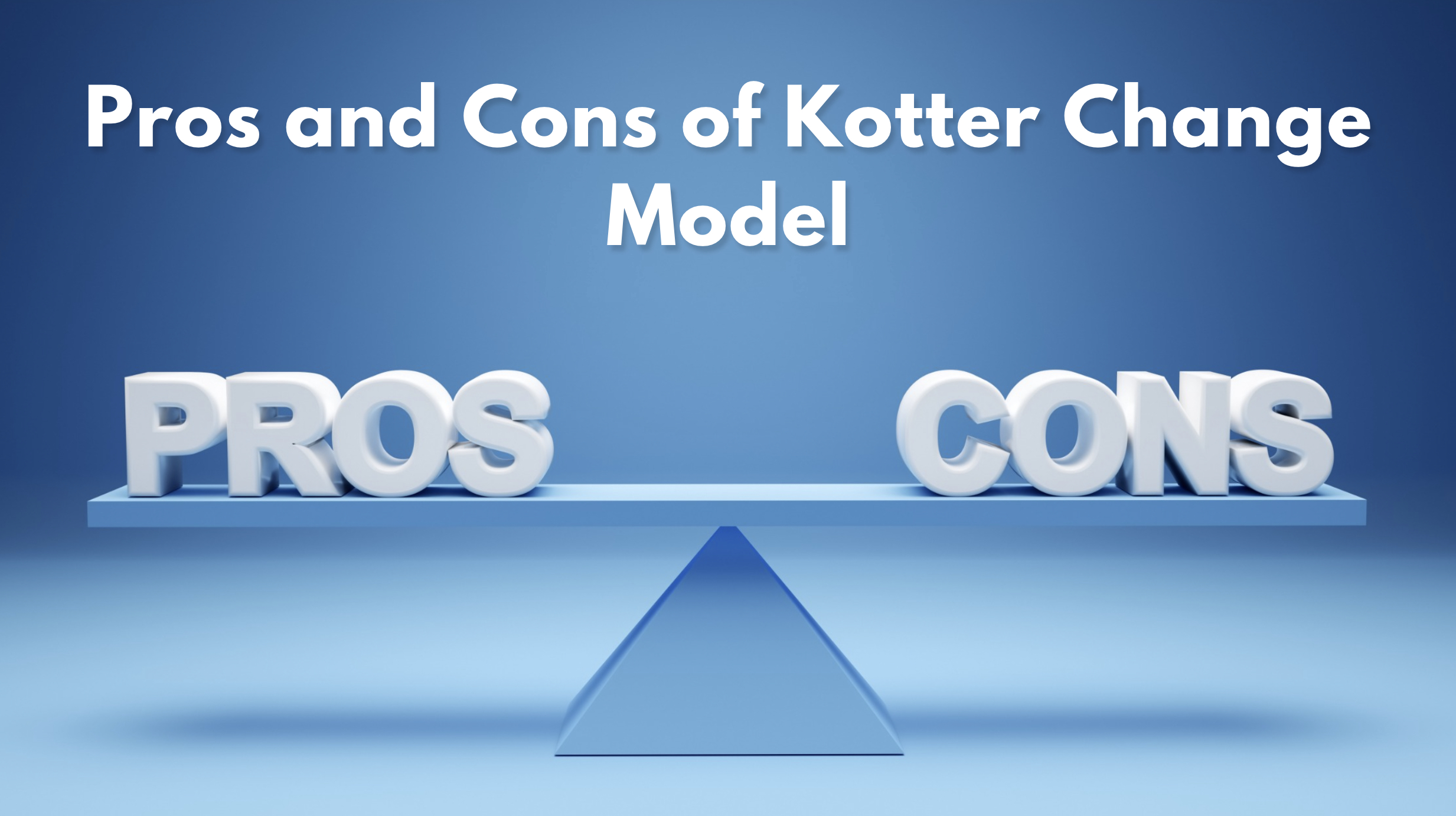
Kotter 8 Steps Pros and Cons
There are several other well-known change methodologies you can choose from. So, how do you know if Kotter’s change management theory is your best bet for the results you are looking for?
Let’s dig in and find out.
See Also: Should You Get a Prosci Certification in Australia or NZ?
Do you have questions or input about this Kotter’s 8 step change model pros and cons guide that you believe can be of value to other change management practitioners? Click here to contact the OCM Solution Team.
First, What are Change Models?
Why do you need a change model in the first place? What are change models, exactly?
Any time you change the way that people are doing things in their daily work to something different, it involves many moving parts. A change model is a framework that offers steps, methodology, and a core philosophy that you can use to drive a successful transition.
Organizational changes can include events like:
- Adding new locations
- Moving from a manual process to an automated one
- Changing a cloud app that you use
- Adding a new product or service
- Creating a new division and reorganizing job roles
- Going through a corporate merger or acquisition
What change models, such as the John P Kotter leading change method, offer is a road map with steps you can take to help your organization and team members through a change successfully.
A KPMG Global Transformation Study found that over half (53%) of organizations undergoing change don’t see sustainable value from their efforts. In many cases, this is because of a lack of a change model and plan.
Some of the change models in addition to the John P Kotter leading change model are:
Something seemingly as simple as switching to a new system can end up failing if the right framework isn’t used to guide the change. So effective change methodologies allow you to efficiently identify the factors in a company that can help or hinder change, such as employees’ feelings about the change.
How you approach organizational change has a big impact on the success of the change implementation, which is one reason why the Kotter 8 Steps of change is so popular.
Do you have questions or input about this Kotter’s 8 step change model pros and cons guide that you believe can be of value to other change management practitioners? Click here to contact the OCM Solution Team.
What is the Kotter Change Model?
Dr. John P. Kotter created the John Kotter change management model. His background in business administration and the science of management laid the groundwork for Kotter’s eight-step change model and Kotter consulting, his business consulting firm.
Where some change models take a bottom-up approach and focus on employee perspective to change, the John Kotter 8-step change model takes a more top-down approach. It is also hyper-focused on creating and maintaining a sense of urgency.
So, what is Kotter’s 8-step change model?
The John Kotter change management model includes the following methodologies:
- The Change Process: 8-Steps to change
- Change Principals: 4 principals to guide change
Kotter’s 8-step process is designed to ensure change managers have created the right environment to effect change, develop the support they need to make the change happen, and keep the momentum going throughout the change, so things don’t stall.
Businesses adopting Kotter’s 8 stage model, will find the stages fairly straight forward, which is a benefit for those new to change management.
Do you have questions or input about when to use Kotter’s change model or need more details on Kotter’s 8 steps advantages and disadvantages? Click here to contact the OCM Solution Team.
What is the John Kotter Change Model? When Was it Developed, and Why is Kotter’s Change Model Good?
Kotter’s eight steps of change were first introduced in 1995 in an article written by Dr. Kotter and published in the Harvard Business Review. The article, titled “Leading Change: Why Transformation Efforts Fail,” outlined the main barriers he saw companies face when trying to transition.
These observations that lead to the development of Kotter’s 8 stage change model came from his many years of watching over 100 companies remake themselves to become more competitive.
He mentions companies like Ford, General Motors, and British Airways as well as notes that smaller corporations were also included in his observations that helped him develop the Kotter organizational change methodology.
Kotter’s 8-step change management model was born from lessons learned by watching failed change projects and successful ones. These lessons included:
- Successful change processes require a series of steps. They take time, and while skipping steps may seem to make the process go faster, it contributes to project failure.
- Critical mistakes in any phase of change can have a devastating impact.
Each of the 8 steps is derived directly from 8 errors that he saw companies making, which negatively impacted their change projects. We’ll go into those errors and how they relate to the Kotter change model shortly.
As you read through the Kotter 8 steps for change, you’ll see a common thread of the need to create a sense of urgency for change, and really, this is the main philosophy behind the model.
Why is urgency such a main feature of the John Kotter 8-step model?
The answer can be found in a quote that was in a book by Dr. Kotter, “A Sense of Urgency.”
He stated, “If urgency drops sufficiently and momentum is lost, pushing complacency away a second time can be much more difficult than it was the first.”
Don’t Miss: Is the Prosci Training Worth? All You Need to Know
Do you have questions or input about Kotter’s 8-step change model pros and cons, or need more details on the benefits of Kotter’s change model? Click here to contact the OCM Solution Team.
An Overview of Kotter’s 8 Steps to Change Management – Why use Kotter’s change Model.
Let’s talk about those errors mentioned by John Kotter in his article, which are the base for Kotter’s 8-step change model.
Understanding the problems each of the 8 steps in his process is designed to correct, will give you the right frame of reference to understand Kotter’s 8-step model more fully.
Here are the major errors John Kotter observed that caused failures when organizations tried to implement change. This section aims to answer the often asked question: “What is kotter’s 8 step change model used for?”
#1: Not Establishing Enough Sense of Urgency
If people aren’t motivated to change, it’s going to be difficult to get them to move from the current way of doing things. While management may be driven by the bottom line, employees can have completely different motivations.
Failure to properly motive with a sense of urgency for the change is one of the biggest reasons change stalls or fails. John Kotter stated that he’s seen over 50% of companies fail due to failure to create a great sense of urgency.
#2: Not Creating a Powerful Enough Guiding Coalition
Another error is underestimating the power of leadership to help drive a change forward. A John Kotter leading change requirement is that a coalition of leaders should be created as a powerful force to move change in a positive direction and help sustain that sense of urgency.
#3: Lack of a Vision
Dr. Kotter mentions that in every successful change transition he’s seen, there is a comprehensive and easy-to-envision picture of what the future state will look like after the change.
Lack of that vision makes it hard to create the willingness or desire to change among stakeholders (employees, managers, etc.).
#4: Under Communicating the Vision by a Factor of 10
Credible and clear communication by “hundreds or thousands” of people willing to help is needed to ensure the vision is understood by all.
Failure to do this properly makes it hard to get people on board with a change because they’re not being moved by a vision of a better future.
#5: Not Removing Obstacles to the New Vision
Both attitudes and organizational structure can become obstacles to change. Another big mistake that’s addressed in Kotter’s change management theory is the failure to be ready for and remove roadblocks to your change project.
#6: Not Including Short-Term Wins in a Change Strategy
Going back to urgency… another mistake that causes change efforts to fail is not giving people milestones they can celebrate to document short-term wins.
The change process is more like a marathon than a sprint, and those short-term wins are akin to the people on the sidelines cheering and handing out water as runners go through a 10K.
Without short-term wins to celebrate, leaders and employees can easily get tired of the change process, become complacent, and lose that all-important urgency.
#7: Declaring Victory Too Soon
Thinking a change project is completed too soon and turning your attention away from the process can lead to a rebound of old habits.
Efforts to sustain and nurture change past the initial “go-live” date of your project are vital to ensuring change doesn’t evaporate.
#8: Not Anchoring Changes in the Corporate Culture
The ultimate goal is to change the “new way” of doing things into “the way things are done around here.” This requires attention to behaviors, habits, and adjusting the corporate culture to embrace the changed process.
Not doing this anchoring can lead to resistance to the change bubbling up and people falling back into old “pre-change” habits.
Related: Prosci Certification (Pros & Cons)
What are Kotter’s 8 Steps to Change?
You now know the reasoning behind Kotter’s eight-step model and what errors it was designed to correct, so let’s get into the details of the model itself.
Kotter’s 8-step change model examples were meant to be a corrective action, really, rather than an entirely new philosophy. The steps are designed to correct the errors that Kotter observed over multiple organizational change projects.
Overview of Kotter’s eight steps:
- Create a sense of urgency
- Build a guiding coalition
- Form a strategic vision and initiatives
- Enlist a volunteer army
- Enable action by removing barriers
- Generate short-term wins
- Sustain acceleration
- Institute change
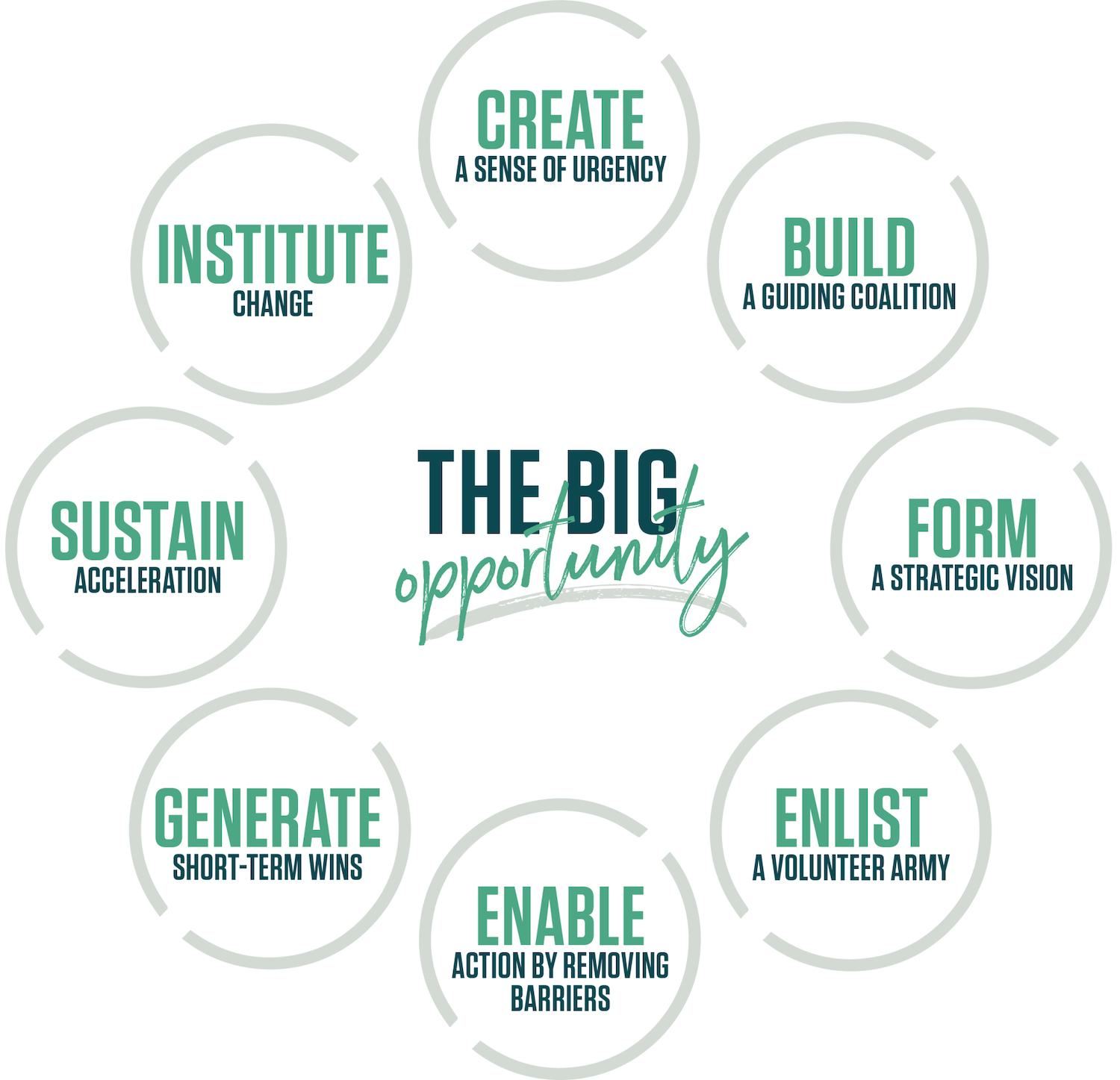
Kotter Change Model | Kotter’s 8-Step Process
Now, let’s go a little deeper into each step in the John Kotter change model and how it helps to guide a successful organizational change project.
What is the First Step in Kotter’s 8-Step Approach?
We’ll start with the first step, which is the heart of the entire Kotter’s theory of change, which is to create urgency. In his writings, it is evident that he feels this is key to doing all the other steps successfully, and some of the steps are designed to fan the flames of urgency, so it doesn’t go out.
Step 1: Create a Sense of Urgency
Unless people are motivated to change and understand how change is going to benefit them and the organization, moving them where you need them to be is going to be difficult.
This first step discusses the need to create a bold, aspirational statement that people can immediately attach onto that will give them excitement for the future state (post change).
You want people to not only understand why things are changing but feel that sense of urgency to get to the other side of the change.
Step 2: Build A Guiding Coalition
Dr. Kotter explains in his 1995 paper, which was the base of the John Kotter 8-step model, that failure can easily happen when you don’t have a coalition of leadership banded together to communicate your vision.
You should gather a team of varying levels of authority, gender, ideas, functions, and tenure that can become your coalition to guide the change. For smaller companies, this can be 3-5 people, and in larger enterprise organizations, it can be as many as 20-50.
Guiding this coalition will involve leadership coaching.
Step 3: Form a Strategic Vision and Initiatives
The third step in the John Kotter change management model is key to creating urgency because you need to have a clear strategic vision to energize individuals for the change.
Characteristics of a strategic vision described in Kotter’s eight-step change model are:
- Communicable
- Desirable
- Creates a verbal picture
- Flexible
- Feasible
- Imaginable
- Simple
Your strategic initiatives will be the steps that guide your organization through the change. This will be your change management roadmap, and it can include various activities, including making an employee training plan, creating a plan for change communications.
Some may feel this step is out of order in the John P Kotter leading change model because you need the vision to create urgency (step 1), but we’ll get into that later when we discuss Kotter 8 steps pros and cons.
Step 4: Enlist a Volunteer Army
Another important action you should take to ensure your change project is successful is to enlist an army of volunteers throughout your organization to help drive change and ensure people continue to feel the urgency to change.
While the John Kotter 8-step change model refers to this group of people as a “volunteer army,” you’ll find other models calling this group “change champions” or “change agents.”
Kotter’s 8 stage model notes that this group of employees you secure to help champion the change should be volunteers and be empowered to step up and act.
This step of the Kotter change management 8 steps framework would include creating and managing your army. According to John Kotter’s 8-step change model, about 15% of your organization is enough to help build momentum for the change.
Step 5. Enable Action by Removing Barriers
A quote about the Kotter organizational change philosophy by Dr. Kotter describes the motivation behind this step. It is, “Innovation is less about generating brand new ideas and more about knocking down barriers to making those ideas a reality.”
Barriers that inhibit your change can be unnecessary bureaucracy and the attitudes of stakeholders and leaders. You may hear grumblings such as, “We’ve always done it THIS way, and it worked just fine” or “Whenever we do something like this, it never works!”
Barriers can also include things like budget constraints and complacency. Anything that can inhibit your change project is a barrier.
According to the Kotter 8 steps of change methodology, these barriers need to be identified and removed. You can look at past projects and see what caused them to fail. Another way to address barriers is through a resistance management plan.
Step 6. Generate Short-Term Wins
This next step in Kotter’s 8 steps for leading change is important for keeping momentum and urgency going throughout the change project.
Change projects can take a long time, and stakeholders and leaders need to see progress in the form of short-term wins that they can get excited about. Short-term wins also help gauge how your project is going and provide quantifiable results along the way.
Step 7. Sustain Acceleration
This step in Kotter’s 8 steps for leading change is another reminder of the focus of urgency in his change model. He states that you should be “relentless” in pursuing each next step in the change transformation, especially after you get those short-term wins.
The short-term wins lead directly into this part of Kotter’s eight-step plan for implementing change because they’ll give you more credibility for the change project.
Resting on your laurels after a few wins can cause complacency at a critical juncture in your project. So rather than allowing that to happen, Kotter’s eight steps of change say you should put your foot in the gas pedal instead.
Step 8. Institute Change
This is the point in the John Kotter change management model that you want to ensure the change your organization has gone through is sustained and anchored in your corporate culture. You don’t want people to fall back into old “pre-change” behaviors.
According to Kotter’s 8 stage change model, you need to articulate how these new behaviors and processes benefit the organization. You want to connect the dots between this new way of doing things and the organization’s success.
Steps 1 through 7 in Kotter’s 8-step change management model are described as “accelerators” designed to build new behaviors (“muscles”), and step 8 is about making sure those new behaviors stick.
How is John P Kotter’s Theory of Change Used? 4 Change Principals
Alongside the Kotter 8 steps change model are 4 change principals that are used to help guide the “people” part of your change management planning.
They’re designed to give you insights into your leaders, volunteer army, and other stakeholders as you work through Kotter’s 8-step change model.
Leadership + Management
This principle emphasizes the importance of having leadership onboard to help drive the change project. This is more than just one executive. The leadership team you build in Step 2 of Kotter’s 8-step model should include leaders of different titles.
This principal notes that the leadership team is about:
- Vision
- Action
- Innovation
- Celebration
Head + Heart
The desire to contribute to a larger cause and be a part of something can be a bigger motivator for some people than the logic that the change will be more effective or productive.
This principle of the John Kotter leading change model is a reminder to understand the different motivations people have so your strategy can incorporate them.
Select Few + Diverse Many
Rather than just giving people directions, you want to provide them with an opportunity to become leaders. When you’re building your volunteer army in Step 4 of the John Kotter leading change model, it’s important to empower people so they can feel they’re part of the project.
This principal in Kotter’s change management theory mentions that if you perform this right, you may just find new leaders that you didn’t know were there.
“Have To” + “Want To”
This principle in the Kotter change management model is another state that people respond better and can become better change champions if they WANT to help rather than are just doing as they are told.
This is why it’s important that both the leaders and army you enlist as you’re going through Kotter’s eight-step model be volunteers.
How Businesses Can Apply John Kotter’s 8 Steps
There are a few different roads you can take to apply Kotter’s 8-step change model examples to your company’s change project.

Kotter Change Model Pros & Cons
Work with a Consultant
You can work with a consultant that knows the John Kotter change model, or with John’s organization itself. Kotter consulting offers help with organizational transformations using the John Kotter change model.
Go Through Workshops/Training
If you’d rather have your own team take you through the John Kotter change model, you can send key employees to workshops offered by Kotter consulting. The firm offers one and two-day workshops based upon Kotter’s theory of change, his research, and books.
This could give your team the skills they need to lead and manage change projects at your company now and in the future using Kotter’s eight steps.
DIY with Self Learning
If you’d rather do it all yourself, you can access eBooks, articles, and other information online related to the John P Kotter leading change management model. By using this information, you can develop your own internal planning materials to drive your change program using the John Kotter change management philosophy.
Pros: Why Should We Use Kotter’s Eight Steps of Change?
Is the John Kotter 8-step model the best fit for your organizational change project?
When looking at the pros and cons of Kotter’s change model, some organizations will find the advantages win out, while others may want a more bottom-up model.
When deciding on a change model to use for planning organizational transitions, it’s important you take a look at Kotter’s 8-step change model pros and cons (and those of any model under consideration).
While different change methodologies may all be focused on the same end goal, how to change successfully, they often go about this in very different ways. While the Kotter 8 steps of change may be right for one company, another may find it’s not the best model for them.
Here are some of the advantages of using Kotter’s 8-step process.
The First Three Steps Set You Up for Success
Kotter’s eight-step change model is one of the only ones you’ll find that puts such an emphasis on the importance of generating and sustaining urgency throughout the change process.
This mindset going in can set you up for success by infusing your leadership team with that urgency, creating a vision to express it, and keeping that momentum as a core objective.
Many change projects end up stalling or taking longer than they need to (running up costs) because they don’t have that sense of urgency promoted in the John Kotter 8-step change model.
The Steps are Clear & Easy to Follow
Each of the steps in Kotter’s 8-stage model is pretty straight forward and easy to follow. There is not a ton of change theory that someone needs to learn to adopt the Kotter change management 8 steps and implement them in their organization.
This can reduce the time it takes to get a team ready to promote change and the cost of training that team. There are several online resources that can be tapped to learn John Kotter’s 8-step change model, and it doesn’t take long to pick up the basics.
It Emphasizes the Importance of Getting Help & Motivating
Change projects can often fail when too few people are driving the change, and they haven’t put together a coalition to help them.
You can’t be everywhere at once, and Kotter’s 8 steps for leading change express the importance of assembling a coalition of diverse leaders at the beginning and enlisting an army of people to help drive change and keep the momentum going. It also emphasizes how to keep them motivated (i.e., short-term wins).
The 4 principals used in Kotter’s eight-step plan for implementing change give tips on how to enlist that help.
Cons: What are the Drawbacks of the John Kotter Change Management Model?
What is Kotter’s 8-step change model’s biggest drawback? In looking at the pros and cons of Kotter’s change model, you have to consider both and weight them accordingly with your organizational needs.
When reviewing Kotter’s 8-step change model pros and cons, there are some great parts of his methodology designed to push change forward and ensure people don’t get complacent about it. However, the Kotter organizational change methodology also has its weaknesses.
Here are some of the drawbacks of Kotter’s 8 stage change model to consider.
It’s Too Singularly Focused on Urgency, Lacks Detail
Some people find Kotter’s 8-step change management model lacking when it comes to the details of how to accomplish the eight steps that are laid out.
It’s great when it comes to the focus on motivation and urgency, but Kotter’s 8-step model isn’t very detailed when it comes to the specifics of what to do.
For example, other change models will discuss things like change impact assessments and change readiness assessments as a way to prepare appropriately for the change, where the Kotter change management method sees forcing the change forward with urgency as the key and lacks all the dots that take you from start to finish.
The Steps Can Seem Out of Order
Another problem that comes up when looking at Kotter 8 steps pros and cons is that because the model was based upon ways to fix those 8 core change errors identified by Dr. Kotter, the steps can seem out of order and without an overarching theme, other than urgency.
For example, when we examine the stages in the Kotter change management theory, Step 3, to create a vision and plan, it seems like it needs to be first because that vision is needed to create the urgency noted in Step 1.
This makes John Kotter leading change steps seem more like tips on what to do rather than a cohesive roadmap.
It’s Too Top Heavy, Not Enough Emphasis on Employees
We’ve found several reviews of Kotter’s change management theory that mention his model seems too top-heavy, meaning it’s a top-down approach that doesn’t focus enough on the people experiencing the change and how it’s going to benefit them personally.
The Kotter change management model is more about forcing change down from the top and how the change is going to benefit the organization as a whole. Kotter’s eight-step model has urgency and removing barriers to motivation as its core components instead of focusing on employees.
What is the Difference Between Lewin’s Model and Kotter’s Model?
Another popular change management model is one developed in the 1940s by psychologist Kurt Lewin. There are some core differences between Kotter’s 8-step change model and the 3-stage model by Lewin.
The first difference is that Lewin’s model is based on a simple overarching roadmap of a change project, where Kotter’s 8-step model isn’t quite as simple. Lewin’s model begins with “Unfreeze,” which relates to unfreezing old behaviors. The next step is “Change,” and the last is “Freeze” to cement new behaviors.
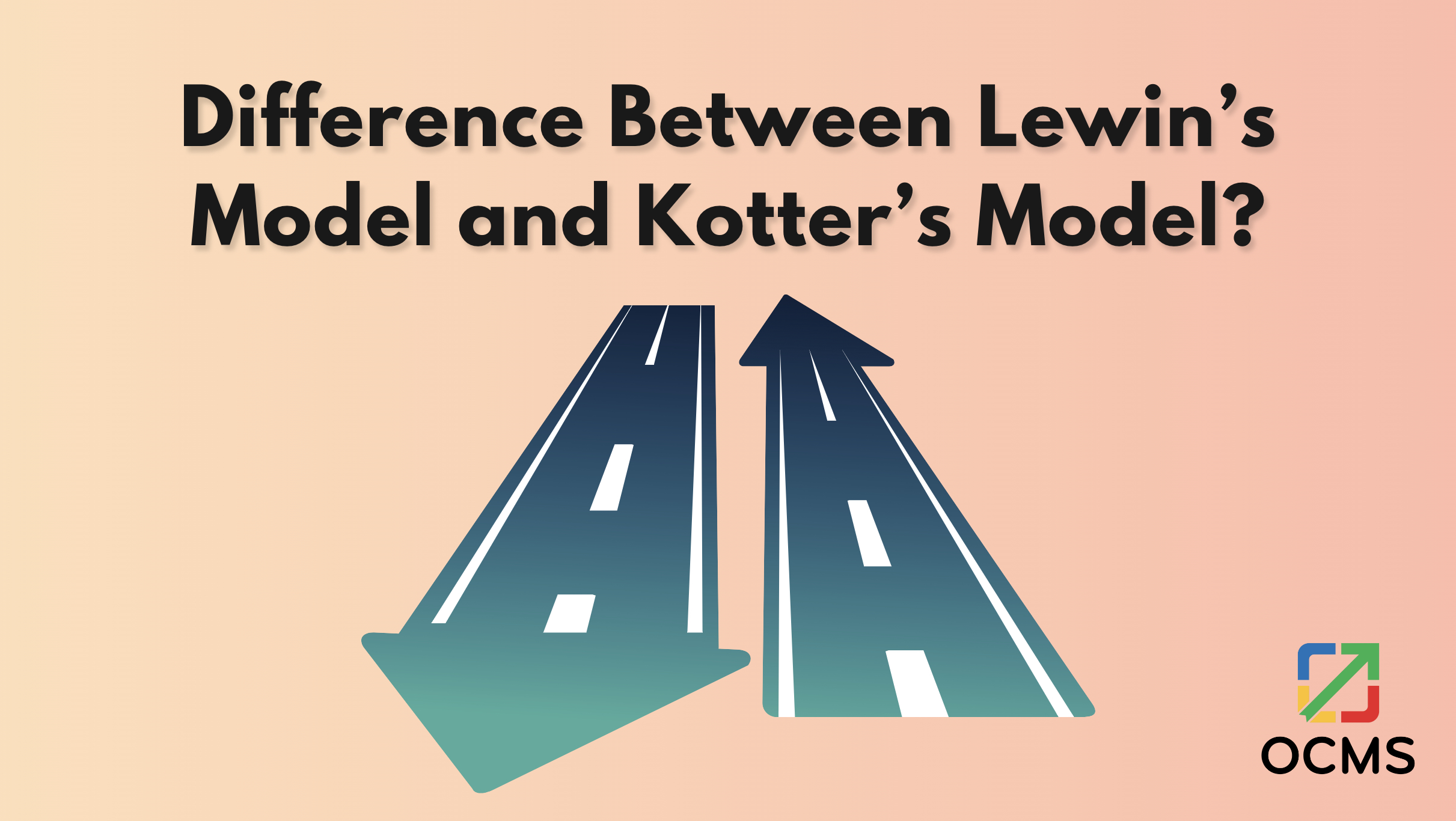
While both the Lewin and Kotter change management theories include that last step to sustain change by cementing new behaviors in corporate culture, Lewin’s theory is more logical than Kotter’s, making it easier for those new to change management to grasp.
Another important difference is that Lewin’s model is based on human psychology, focusing on behaviors that both drive and block change. It emphasizes addressing change from the employee perspective.
The John Kotter leading change model is less concerned with individual behaviors, except when it comes to being motivated about the change and feeling the urgency of the change.
When it comes to detail, Kotter’s change management theory gives you more to work with than Lewin’s. Lewin’s change model, while simple, can be too simple, leaving more blanks that change managers have to fill in on their own than Kotter’s 8-step change model.
Confusion About the Kotter Change Curve
As you’re searching out information on the Kotter change management 8 steps, you’ll run across references to the Kotter Change Curve and also the Kubler-Ross Change Curve.
There seems to be a lot of confusion between the two, so we did some digging to help clear this up and to find out if there is actually a Kotter Change Curve methodology in John Kotter’s 8-step change model.
We found that there is no mention of any Kotter Change Curve on the Kotter consulting website or in the firm’s educational materials of Kotter’s 8 steps for leading change. So, there is no Kotter Change Curve that we can find or that the author’s site mentions.
It appears that some people over the years have confused Kubler with Kotter and assigned the Kubler-Ross Change Curve to John Kotter.
The Kubler-Ross Change Curve is also known as the five stages of grief. It describes the process people go through after a major loss. This includes denial, anger, bargaining, depression, and acceptance.
This methodology has been updated to apply to the business change process with a few other stages added. This updated version of the curve is used to describe the stages that employees go through during organizational change.
You’ll find it expressed with a different number of stages depending upon the resource you’re using, but they are generally seen as:
- Shock
- Denial
- Frustration
- Depression
- Experiment
- Decision
- Integration
While this Kubler-Ross Change Curve is not part of Kotter’s eight-step plan for implementing change, it could be useful to reference alongside it.
Conclusion – This Year’s Understanding of Kotter’s 8-Step Model | Pros & Cons of the Kotter Change Model
For organizations looking for both an easy change model to learn and one that gives them a core component needed to drive success, Kotter’s 8-step change model based upon urgency and motivation is a good option.
The steps contained in Kotter’s 8-step model are easy to follow and can keep change projects from making one of the many mistakes proven to cause project failures.
There are, however, several important considerations on the “con” side when considering Kotter 8 steps pros and cons, namely the lack of a cohesive change plan roadmap and the fact that employee behaviors aren’t the main focus of the model.
Larger organizations that prefer a top-down approach may find the Kotter change management model a perfect fit. But many find that a bottom-up model may be better suited to today’s employees.
Popular Article: Should You Use the Prosci Portal & Toolkits? Pros & Cons
Note: Content on OCM Solution's ocmsolution.com website is protected by copyright. Should you have any questions or comments regarding this OCM Solution page, please reach out to Ogbe Airiodion (Change Management Lead) or the OCM Solutions Team today. OCM Solution was previously known as Airiodion Global Services (AGS).
Images: https://stock.adobe.com/, https://www.kotterinc.com/8-steps-process-for-leading-change/, https://unsplash.com/photos/person-writing-on-white-board-iW9oP7Ljkbg





